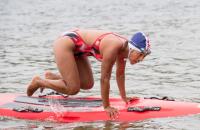A glimpse of history on the rescue board
The use of rescue board by lifeguards is closely linked with the surf history. The creation of rescue board based on transformations to surfboard was accomplished by Americans and Australians.
An Hawaiian surfer as well as Olympic medallist swimmer, Duke Kahanamoku, was the first person to introduce the surfboard to lifesavers.
In 1912, an Australian lifesaving club brought a surfboard from Hawaii but has been unable to use it properly… Nobody knew what to do with a 45 kilos board! In 1915, Duke visited Australia and demonstrated to the lifesavers how to surf on the boards. That was the beginning of the surfing culture in Australia. The lifesavers pursued their efforts to use these boards for rescue, but found them unwieldy and too dangerous.
During that period (1913), Duke visited the US West Coast and struck up a friendship with Roy ‘Dutch’ Miller of the Long Beach, California, lifeguards. Realizing the surfboard utility for rescue, the lifeguards arranged to have modified surfboards made by their city and used them for rescue thereafter. From that point, Americans progressively adopted rescue boards.
Although he was not a trained lifesaver, Duke Kahanamoku performed an extraordinary rescue on June 14, 1925. He was on that day at Corona del Mar, Newport Beach, for picnic and surf activities when a fishing boat sank. Going back and forth three times with his surfboard, Duke saved eight people. And two other surfers also rescued four people.
But this type of rescue equipment wasn’t fully adopted by Australians until 1956. This is when Americans and Australians started to work together to develop what we know today as a truly specific rescue equipment.
Source : TIPTON Mike and WOOLER Adam. The Science of Beach Lifeguarding, United States, Taylor & Francis Group, 2016.






